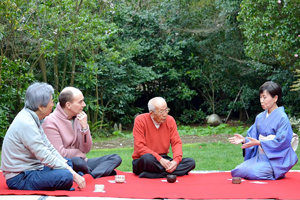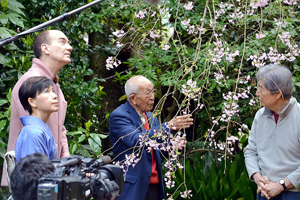April 28 (Thursday)
The final report of the Long-Term Vision HOSEI2030 was completed and reported to the entire university faculty and staff by connecting the entire university via the Internet. The Action Plan working group will now begin its work. Please send your voices for realization from the field to the formulation committee. The Branding Promotion Team has already begun to move forward. We are trying to show what kind of research and education " Practical Wisdom for Freedom " means.
Wednesday, April 27
At the request of "Daigaku Journal," I had a conversation with President Junko Hibiya of International Christian University at the Boissonade Tower. The theme of the discussion was "Nurturing Global Human Resources to Realize a Sustainable Society.
ICU's Super-Global Creation Support Program aims to "create a global university that envisions a sustainable society from Japan, a country with advanced problem-solving capabilities. President Hibiya of International Christian University addressed the "2030 Agenda for Sustainable Development" formulated by the United Nations at last year's graduation ceremony. This Agenda consists of 17 goals for sustainable development to be achieved by 2030. These include overcoming poverty, hunger, and inequality; health and education; peace and justice; sustainable consumption; technological innovation; and combating climate change and the environment.

Hosei University is also promoting sustainability not only in terms of the environment, but also in terms of the stability and sustainability of society and diverse cultures. We must be aware of this agenda as well.
I talked about the efforts of each university, and Dr. Hibiya introduced a very interesting book, The lazy person's guide to saving the world, as an approach to sustainability that anyone can take on. Please enjoy reading it. And please do what you can to help. President Hibiya and I were excited, saying, "I want to make a sequel! We were so excited.
In the evening, I gave a talk show at Kinokuniya Shinjuku to commemorate the publication of the book "Freedom, the Plaza" (Hosei University Press). The guest speaker was Professor Mizuto Kanehara of Faculty of Social Sciences. In this book, he wrote, "This is what happens when you give freedom a human form. The venue was packed. Many alumni attended. We also held an autograph session. Thank you very much for buying the book. The royalties will be donated to the university.
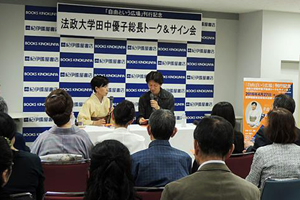
April 25 (Monday)
The emblem for the Olympics was decided to be "Kumiai checkered pattern". The checkered pattern has been used since ancient times, but the name "checkered" was first used in the Edo period. Not only is it a typical pattern for kimono of the Edo period, but the use of indigo and white colors in this exhibition is truly Edo chic. Ryohei Miyata, chairman of the committee (Commissioner for Cultural Affairs), said, "It is one color, taciturn yet polyvalent. It has a Japanese character," he said. The emblem is a combination of three types of squares, from which a fan, an uchiwa fan, and cherry blossoms emerge. It looks three-dimensional and also shows movement. It is a modern revival of an Edo design.
Ryohei Miyata, who became the Commissioner of the Agency for Cultural Affairs, was introduced in the December 10, 2015 President Journal. We worked with him on a special New Year's program on Niigata Broadcasting System.
April 24 (Sunday)
I was on TBS Sunday Morning. Although the main focus of the program was on the Kumamoto earthquake, the entire world can be seen, from the restrictions on refugees in Europe to the various movements taking place in Brazil and other South American countries. Nevertheless, from a global perspective, the fate of the Japanese archipelago cannot be changed. We cannot become a "normal country capable of war. Nor can we become a "rich country dependent on nuclear power. I believe that we must be prepared to live on this archipelago of disasters, and that the first step is to decommission all nuclear power plants and build a country that is resilient to disasters, which I believe will help us to "build a sustainable world.
April 22 (Friday)
We connected the department heads' meetings of the three campuses via the Internet and presented the final report of the long-term vision HOSEI2030 and the report of the Action Plan Working Group for the long-term vision to be developed this fiscal year. We will continue to report several more times, both on and off campus.
April 21 (Thursday)
Today, we received a visit from the "Japan Hosei University Taiwan Alumni Association" from Taiwan. They were people who are active in society, representing companies and corporations, etc. In the 1980s, there were a very large number of students from Taiwan. In Taiwan, they created their own alumni association. We also received a Hosei badge in the shape of Taiwan. I would like to continue to work with alumni and staff members to spread the movement to form this alumni association around the world. The number of foreign students from Taiwan decreased for a while, but it is increasing again thanks to the efforts of the Global Education Center. We are very happy about this.
April 16 (Saturday)
The earthquakes have been continuing from Kumamoto to Oita since the 14th, and the earthquake earlier today caused great damage. I would like to express my deepest sympathies. The University will provide support, including financial assistance as much as possible, to students whose family finances have been affected by the disaster so that they can continue their studies. Please do not give up, consult with the Student Center and continue your studies.
Mr. Hosokawa, whom we met on the 11th, is the 18th head of the Higo Hosokawa family, who were the lords of Kumamoto Castle in the Edo period. The Eiseibunko, which houses his collection of artifacts, is located in Tokyo, but he still has his residence in Kumamoto, and he was also the governor of Kumamoto Prefecture, so I am sure he is deeply concerned about the devastation of Kumamoto Castle and the situation in Kumamoto Prefecture. I would like to express my deepest sympathies for your loss.
April 14 (Thursday)
I used to write a series of articles in a magazine called "Seiryu" and published it in a book titled "Thoughts on the countryside". That "Seiryu" came to interview me for a feature article on how older people should support young people. I mentioned two things: "keep learning" and "financial support.
When people age without learning, they judge the present based on what society was like when they were young. Giving advice and preaching to young people with the common sense of decades ago is just a nuisance to them. By constantly observing society, learning, reading books, and learning about the changes of the times, we can recognize what changes and what does not change, and can give effective advice to the next generation.
Also, it costs money to get higher education and study abroad, and there are two types of young people: those who can afford it and those who cannot. Wealthy seniors can help educate the next generation by bearing a portion of the younger generation's educational expenses or making donations, rather than spending the money on themselves alone. The number of endowed scholarships at the University is increasing. We would like to spread this kind of movement.
April 12 (Tuesday)
We were interviewed for "Weekly Toyo Keizai, Really Strong Universities 2016. With internationalization advancing, the number of women increasing, and the number of applicants surpassing 100,000, Hosei University is now attracting "What's Next?" The university is attracting a lot of attention. We were asked about competition with other universities and with universities around the world. The direction in which Hosei University is heading is not to be at the mercy of competition while comparing ourselves with others, but to continue to grasp and express the unique characteristics that Hosei University itself possesses. I talked about what we envisioned in our long-term vision and what kind of university Hosei University is.
The graduate school classes have started. There are nine doctoral students in my seminar this year, including those on leave. Seven of them are foreigners. I hope they will be successful in obtaining their doctoral degrees.
April 11 (Monday)
There was a cherry blossom viewing party at the residence and studio "Butouan" of former Prime Minister Morihiro Hosokawa, who is now a ceramic artist and painter, for the shooting of a documentary film about Mr. Hosokawa. However, there were only three guests: Mr. Toemon Sano, a gardener since the Edo period and now a cherry tree doctor; Mr. Robert Campbell, a scholar of Edo and Meiji literature; and myself.
The house is a small, but very spacious garden, house, and workshop on a hill in Yugawara, with a treehouse-style teahouse. I have visited there several times for flower viewing in spring and for tea ceremonies in late autumn.
Most of the cherry trees in the center of Tokyo, such as Yasukuni, Kudan, and Sotobori, are Someiyoshino cherry trees. There are no Someiyoshino in this garden. Oshima-zakura and yamazakura are trees that grow through crossbreeding, but someiyoshino are clones made by grafting branches without crossbreeding. The Someiyoshino, on the other hand, is a clone made by grafting branches together without crossbreeding. Mr. Campbell and I were surprised to hear Mr. Sano say, "This cherry tree has a trunk, but the Someiyoshino does not have a trunk, only branches. We were thinking about various things.
April 8 (Fri.), 9 (Sat.)
I made a business trip to Fukuoka. On the morning of January 9, a monument was unveiled at the Ogasawara Shrine in Toyotsu, Miyako-cho, Miyako-gun, Fukuoka Prefecture, dedicated to Hosei University's first president, MATSUMURO Itsu, who was the first president of the university when it was established under the University Ordinance.
As is well known, Hosei University was founded in 1880 under the name "Tokyo Hogakusha" (Tokyo Law School) to teach law. Later, it evolved into a Japanese-French law school and was renamed Hosei University. President Matsumuro purchased the current Ichigaya Campus and submitted a notification to the Ministry of Education, and as a result of his efforts, Hosei University was officially established in 1920 under the University Ordinance. As a result of his efforts, Hosei University was officially established under the University Ordinance in 1920. At the same time, he was also the Minister of Justice of Japan (currently the Minister of Justice).
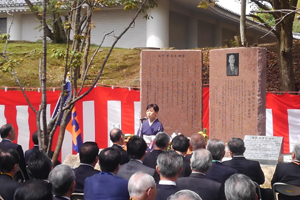
In 1928, when the Security Law was about to be revised to make the death penalty the maximum penalty, President Matsumuro was the only one to express his opinion at the Emperor's Council that "it is wrong to impose the death penalty or life imprisonment based on ideology alone. It is clear that President Matsumuro created a school culture of "freedom and progress" and had the current attitude of " Practical Wisdom for Freedom.
Ogasawara Shrine was built to protect the Ogasawara family, lords of the Ogura domain. President Matsumuro Chisato was the eldest son of a Ogura feudal lord who studied at the domain school. A junior and senior high school derived from the clan school is located nearby. The Miyako Town Museum of History and Folklore, located next to the shrine, houses materials on Toyotaka Komiya, a student of Soseki Natsume. Many of the literary and philosophical figures under Soseki Natsume were on the faculty of Hosei University, so the exhibits in this museum are also related to the university. If you have a chance, please visit the monument.
April 7 (Thursday)
The Graduate School's meeting body began this year with a new name, the Graduate School Dean's Meeting, which is a straight representation of what it is about. I handed over the letter of resignation to the new Dean of the Graduate School. The Dean's Meeting for the new academic year is also starting. For the first time, we have begun to hand over the letters of resignation to the new deans. The Dean's Meeting is a place where the deans representing the Faculty Senate combine their abilities to solve the university's teaching and learning issues. I ask all of you to return further suggestions in response to proposals and to ensure that the discussions are fruitful.
April 6 (Wed)
The Executive Trustee also welcomed the new year, and the new general managers were present at the meeting. I told them that I wanted to make the meeting a body where more active discussions could take place.
April 5 (Tuesday)
As part of the training for new employees, I gave a lecture. These young employees were entrusted with the future of Hosei University, despite the competition being about 100 times higher than the average. I would like to thank all the staff members who made the new employees' attitude as polite and firm as if they were attending an athletic event. This atmosphere will gradually soften. And it is up to me and the Trustee to make this an open university where fresh comments and suggestions can emerge.
April 4 (Monday)
Each of the affiliated schools also held their own entrance ceremony. The President goes around to the entrance ceremonies of the three affiliated schools in turn. This year, he delivered congratulatory speeches at the entrance ceremony of the Second Junior High School and the entrance ceremony of the Second Senior High School. The new school building and the change to a co-educational school are a new start for the school. With the addition of female junior high and high school students, the atmosphere of the school seemed to have become more positive and motivated.
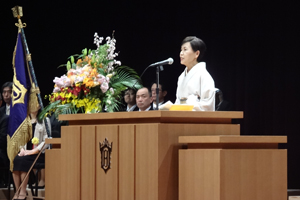
April 3 (Sunday)
It was an entrance ceremony. Congratulations to all the new students! The ceremony was held in two parts, one in the morning and the other in the afternoon, and was filmed by NHK television cameras. The Nippon Budokan was so packed that some parents had to stand. We apologize for the inconvenience. The Kudan area was crowded with cherry blossom-viewing visitors. I guess they couldn't even have lunch. The number of students who took the entrance examination was the largest ever since the beginning of the university, and as a result, the number of students enrolling in the university was also larger than usual. Although the Ichigaya Campus is undergoing renovation, we will do our best to ensure that everyone has an accident-free and fulfilling student life.
Also, starting from this year's entrance ceremony (afternoon session), we have decided to ask those who have graduated 50 years ago to attend the ceremony. Thank you very much for coming. The atmosphere of the ceremony became even more relaxed.
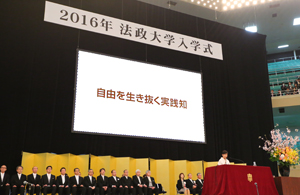
April 2 (Saturday)
There was an all-day workshop for new university faculty members. This year, I gave a talk centered on the Hosei University Hosei University Charter, which was created in the process of formulating the long-term vision. Both young and distinguished teachers will gather at Hosei University to teach. This year is a particularly vibrant new semester.
April 1 (Friday)
Finally, the 2016 academic year has begun. Today, we had an inauguration ceremony for new staff members and new teachers of affiliated schools, and handed each of you a letter of resignation. We will head into this academic year starting with the Hosei University Hosei University Charter with renewed spirit.


